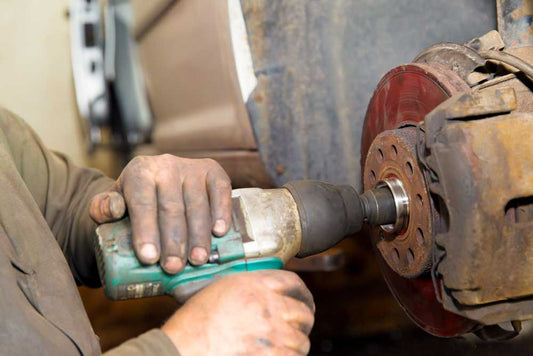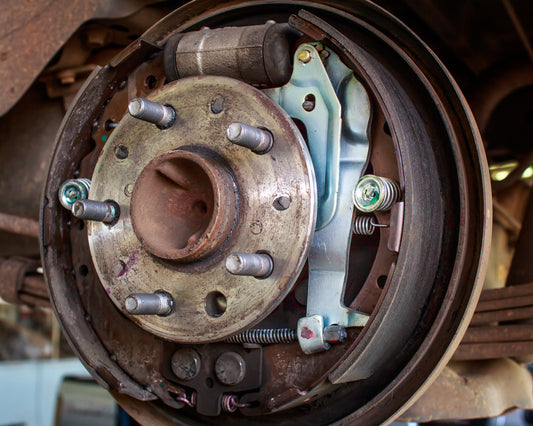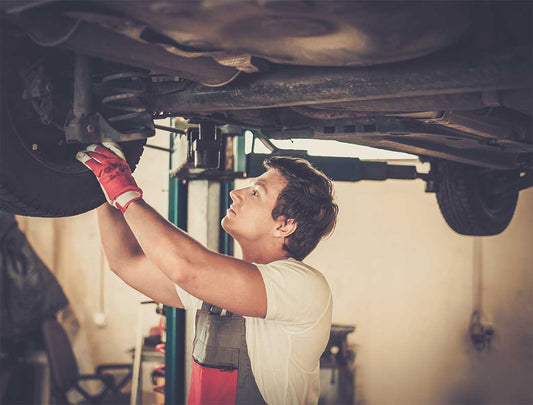- Service and parking brake adjustment
- Rear brake hardware
- Shoe lands or bosses
- GM clip in wheel cylinders
- Brake drum condition
- Brake shoe contamination
- Brake valving
- Friction material
- Does the problem occur under light, moderate or panic stopping conditions?
- Is it a one wheel or axle problem?
- Does the problem occur on dry road surfaces or only when the roads are wet or slippery?
- Is the problem related to any brake work that has recently been performed?
- is the vehicle equipped with a front to rear or diagonal split hydraulic system?
- Does the vehicle have rear drum or rear disc brakes?
- What kind of valving is the vehicle equipped with?
- Think about the system
- Think about how it operates
- Think about the problem
- Determine possible causes
- Apply a logical diagnostic approach
 This 5 step diagnostic process can be applied to virtually all brake problems. The problem many technicians have are because they try and start at step 3. Skipping steps 1 and 2 or not having a clear enough understanding of the system and how it operates are what get many technicians into trouble.
This 5 step diagnostic process can be applied to virtually all brake problems. The problem many technicians have are because they try and start at step 3. Skipping steps 1 and 2 or not having a clear enough understanding of the system and how it operates are what get many technicians into trouble. Rear wheel lockup problems come in two broad categories. The first and most common are those caused by mechanical problems in the rear brakes. The second are those caused by hydraulic problems in the system. Hydraulic problems are far less common but should not be overlooked. When applying step 4 in the 5 step diagnostic process it is important to get into the habit of listing the possible causes inthe order of most common to least common. This approach allows you to find the problem in the shortest time. Service & Parking Brake Adjustment One of the most common causes of one or two wheel lockup on drum brake equipped vehicles is the service and/or parking brake adjustment. If either one or both of these adjustments are done incorrectly it can result in the rear brakes being very sensitive. It is important that before the service brakes are adjusted that the parking brake adjustment be checked. If the parking brake system is not de-adjusted properly before the brake shoes are adjusted it will cause the rear brakes to engage too soon. This is especially true of vehicles equipped with duo-servo rear drum brakes (see Figure 61.1). The most accurate method of checking the parking brake on these vehicles is to check the strut bar’s anti-rattle spring. Figure 61.2 shows the spring the way it should be – relaxed. Figure 61.3 shows the spring in a compressed state. This means the strut bar is being pressed into the primary brake shoe which will prevent it from resting against the anchor pin. This will cause an over sensitive rear brake which could lead to a lockup condition. To check the parking brake on this type of vehicle grab the strut rod and try to move it toward the primary shoe. It should move between 1/16” and 1/8” of an inch. If it won’t move then de-adjust or repair the parking brake system.
 Figure 61.1
Figure 61.1 Figure 61.2
Figure 61.2  Figure 61.3
Brake shoe adjustment is another common cause of rear brake lockup. It is generally accepted that rear brakes should be adjusted until a slight drag is felt. This procedure only applies to a small handful of older vehicles. The methods listed by the vehicle’s manufacturer’s vary widely and sometimes incorporate some rather odd steps. A good generic approach to use is to quick set the shoes to the drums and then use the vehicle’s self-adjusting system to complete the process. Vehicles with duo-servo rear drums (Figure 61.1) should have several stops made when backing up. This will complete the adjustment. Most FWD vehicles self adjust when braking while the vehicle is moving forward (See Figure 61.4). Once the rears are quick set test drive the vehicle to finish the adjustment process. It should be noted that this procedure will only work if the self adjusting system is functioning properly.
Figure 61.3
Brake shoe adjustment is another common cause of rear brake lockup. It is generally accepted that rear brakes should be adjusted until a slight drag is felt. This procedure only applies to a small handful of older vehicles. The methods listed by the vehicle’s manufacturer’s vary widely and sometimes incorporate some rather odd steps. A good generic approach to use is to quick set the shoes to the drums and then use the vehicle’s self-adjusting system to complete the process. Vehicles with duo-servo rear drums (Figure 61.1) should have several stops made when backing up. This will complete the adjustment. Most FWD vehicles self adjust when braking while the vehicle is moving forward (See Figure 61.4). Once the rears are quick set test drive the vehicle to finish the adjustment process. It should be noted that this procedure will only work if the self adjusting system is functioning properly.  Figure 61.4
Caution: If after using this procedure you are not satisfied with the brake pedal DO NOT over adjust the rear brakes to fix the pedal. Use line locks to isolate the problem and then find the cause. Rear Brake Hardware
Rear brake hardware plays an important part in proper rear brake operation (See Figure 61.5). Many people think of return springs as only a way to release the brakes but in reality they also determine when the rear brakes are going to apply. A weak return spring will allow the brakes to engage too soon. This could cause that rear wheel to lockup. Hold down springs are designed to keep the brake shoe firmly against the backing plate. If the hold down springs are weak then the shoe could cock causing a binding condition. The replacement of rear shoe hardware should be suggested each time the rear brake shoes are replaced to prevent this from happening.
Figure 61.4
Caution: If after using this procedure you are not satisfied with the brake pedal DO NOT over adjust the rear brakes to fix the pedal. Use line locks to isolate the problem and then find the cause. Rear Brake Hardware
Rear brake hardware plays an important part in proper rear brake operation (See Figure 61.5). Many people think of return springs as only a way to release the brakes but in reality they also determine when the rear brakes are going to apply. A weak return spring will allow the brakes to engage too soon. This could cause that rear wheel to lockup. Hold down springs are designed to keep the brake shoe firmly against the backing plate. If the hold down springs are weak then the shoe could cock causing a binding condition. The replacement of rear shoe hardware should be suggested each time the rear brake shoes are replaced to prevent this from happening. 
 Figure 61.5
Shoe Lands or Bosses
The shoe lands or “bosses” are an often overlooked item when looking for the cause of a rear wheel lockup condition. The shoe lands keep the brake shoes square with the drum and provide a friction surface for the shoes to move against. Over time the bosses can become grooved and corroded as in Figure 61.6. This grooving can allow the brake shoe to hang on either the apply or release of the brakes which can cause lockup. The shoe lands should be checked during the inspection and if rear brake service is performed they should be cleaned and lubed.
Figure 61.5
Shoe Lands or Bosses
The shoe lands or “bosses” are an often overlooked item when looking for the cause of a rear wheel lockup condition. The shoe lands keep the brake shoes square with the drum and provide a friction surface for the shoes to move against. Over time the bosses can become grooved and corroded as in Figure 61.6. This grooving can allow the brake shoe to hang on either the apply or release of the brakes which can cause lockup. The shoe lands should be checked during the inspection and if rear brake service is performed they should be cleaned and lubed.  Figure 61.6
GM Clip in W/C
GM has used a clip in style wheel cylinder for many years (See Figure 61.7). The shape of the backing plate mounting hole keeps the wheel cylinder from rotating. As the backing plate and wheel cylinder rust this fit is affected which allows the wheel cylinder to rock as the brakes are applied. This rocking can be enough to cause the wheel to lockup during certain types of braking. The typical fix when this occurs is to replace the wheel cylinder and backing plate. Always check these types of wheel cylinders for proper fit during the brake inspection.
Figure 61.6
GM Clip in W/C
GM has used a clip in style wheel cylinder for many years (See Figure 61.7). The shape of the backing plate mounting hole keeps the wheel cylinder from rotating. As the backing plate and wheel cylinder rust this fit is affected which allows the wheel cylinder to rock as the brakes are applied. This rocking can be enough to cause the wheel to lockup during certain types of braking. The typical fix when this occurs is to replace the wheel cylinder and backing plate. Always check these types of wheel cylinders for proper fit during the brake inspection.  Figure 61.7
Brake Drum Condition
Brake drum condition should be factored in when determining the cause of rear wheel lockup. An out of round brake drum or drums that vary in diameter too much from side to side could cause a one wheel lockup condition (Figure 61.8). Measuring drum runout or out of roundness is not easy in the field. Current micrometers do not allow a repeatable measurement to be taken. Using the brake lathe and a dial indicator is only accurate if the lathe and adapters are in the proper condition. If you suspect the rear brake drum is causing the problem install it on the other side of the vehicle and test drive the vehicle. If the problem moves to the opposite side then you are on the right track, if not continue your quest.
Figure 61.7
Brake Drum Condition
Brake drum condition should be factored in when determining the cause of rear wheel lockup. An out of round brake drum or drums that vary in diameter too much from side to side could cause a one wheel lockup condition (Figure 61.8). Measuring drum runout or out of roundness is not easy in the field. Current micrometers do not allow a repeatable measurement to be taken. Using the brake lathe and a dial indicator is only accurate if the lathe and adapters are in the proper condition. If you suspect the rear brake drum is causing the problem install it on the other side of the vehicle and test drive the vehicle. If the problem moves to the opposite side then you are on the right track, if not continue your quest.  Figure 61.8
Brake Shoe Contamination
Brake shoe contamination can be the cause of rear wheel lockup. If an axle seal or wheel cylinder leaks and contaminates the brake shoe(s) it changes the coefficient of friction. If it is mild contamination then the friction is increased while severe contamination will cause a reduction in friction (See Figure 61.9). A common source of contamination occurs during the installation of new shoes. The grease and brake fluid from the technician’s hands often ends up on the new friction surface. An effective method of preventing this is to put wide masking tape on all the friction before starting the job. Once complete simply remove the tape and the shoes are perfect.
Figure 61.8
Brake Shoe Contamination
Brake shoe contamination can be the cause of rear wheel lockup. If an axle seal or wheel cylinder leaks and contaminates the brake shoe(s) it changes the coefficient of friction. If it is mild contamination then the friction is increased while severe contamination will cause a reduction in friction (See Figure 61.9). A common source of contamination occurs during the installation of new shoes. The grease and brake fluid from the technician’s hands often ends up on the new friction surface. An effective method of preventing this is to put wide masking tape on all the friction before starting the job. Once complete simply remove the tape and the shoes are perfect.  Figure 61.9
The quality of brake shoe can also play a role in causing rear brake lockup on certain vehicles. A prime example of this are GM FWD vehicles that are equipped with duo-servo rear drum brakes. Most FWD vehicles use a non-servo rear drum brake because of the braking balance of a FWD vehicle. These GM vehicles are “over-braked” in the rear which makes them very sensitive to rear brake problems. They are also very sensitive to the type of friction that is used. If the friction has too high a coefficient of friction it could cause the rear end of the vehicle to “squat” when the rear brakes are applied or it could cause rear wheel lockup. If the problem is related to rear shoe replacement and everything else checks out then consider installing a set of premium linings to fix the problem.
An important point to keep in mind when inspecting vehicles for the cause of a rear wheel lockup condition is that more than one of the above conditions could be present. Everything matters some is a good way to look at it. Always look at the big picture when inspecting the rear drum brake system. Several “smaller” conditions can add up to create the lockup condition. Brake Valving
The vast majority of rear wheel lockup problems will be related to the mechanical causes discussed earlier. There will be occasion when the problem won’t be related to a mechanical problem in the rear brakes and you need to be prepared for this. This is a good example of where steps 1 and 2 come into play in the diagnostic process. The only component that could cause rear wheel lockup is the proportioning valve(s).
Figure 61.9
The quality of brake shoe can also play a role in causing rear brake lockup on certain vehicles. A prime example of this are GM FWD vehicles that are equipped with duo-servo rear drum brakes. Most FWD vehicles use a non-servo rear drum brake because of the braking balance of a FWD vehicle. These GM vehicles are “over-braked” in the rear which makes them very sensitive to rear brake problems. They are also very sensitive to the type of friction that is used. If the friction has too high a coefficient of friction it could cause the rear end of the vehicle to “squat” when the rear brakes are applied or it could cause rear wheel lockup. If the problem is related to rear shoe replacement and everything else checks out then consider installing a set of premium linings to fix the problem.
An important point to keep in mind when inspecting vehicles for the cause of a rear wheel lockup condition is that more than one of the above conditions could be present. Everything matters some is a good way to look at it. Always look at the big picture when inspecting the rear drum brake system. Several “smaller” conditions can add up to create the lockup condition. Brake Valving
The vast majority of rear wheel lockup problems will be related to the mechanical causes discussed earlier. There will be occasion when the problem won’t be related to a mechanical problem in the rear brakes and you need to be prepared for this. This is a good example of where steps 1 and 2 come into play in the diagnostic process. The only component that could cause rear wheel lockup is the proportioning valve(s).




